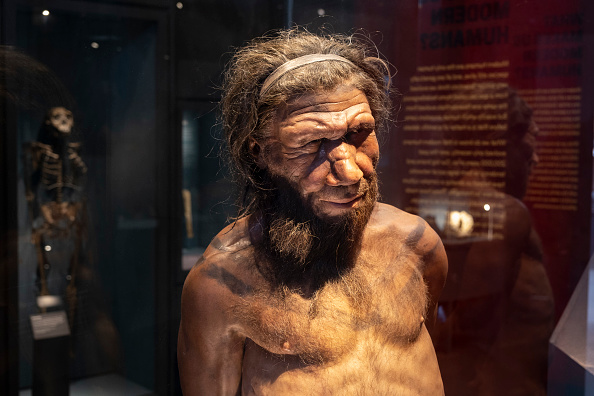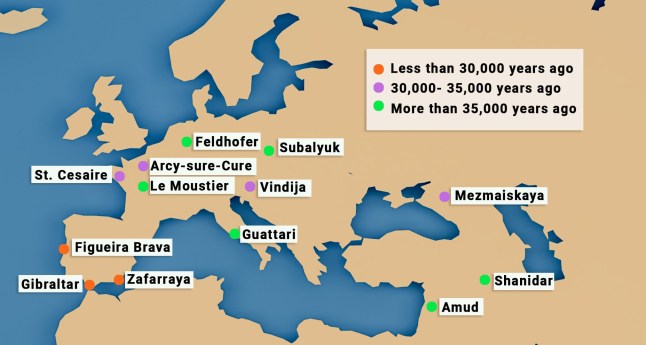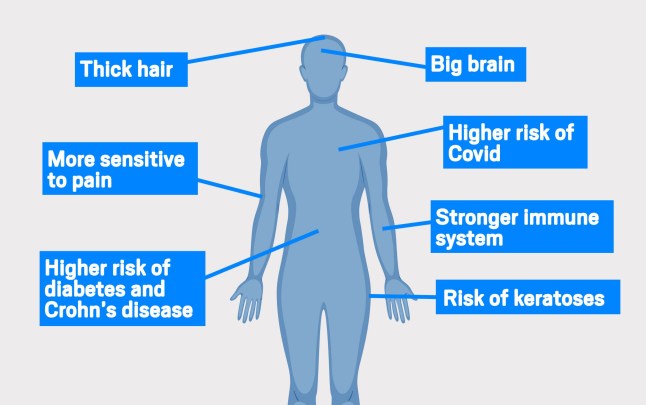
Many of us have a bit of Neanderthal DNA in our genes (Picture: Getty Images)
Modern-day humans can have up to 4% DNA in their genes,more commonly people of European origin.
And as scientists’ understanding of the ancient genome increases,more and more modern traits are being traced back to the time when early humans,Homo sapiens,paired up with their cousins.
Around 250,000 years ago,early humans in Africa started heading towards the cooler climes of Eurasia.
There,they encountered the Neanderthals,our now-extinct relatives,and over centuries these groups mated and exchanged DNA.
Advances in genome-sequencing and fossil discoveries have helped scientists find out more about our long-dead ancestors – with about 2% of genomes of people outside of Africa coming from Neanderthals.
In one example,a study published last year found that people with Neanderthal DNA are more sensitive to certain types of pain.

Does the Natural History Museum’s Neanderthal man look familiar? (Picture: Getty)
The team from University College London found that three ‘Neanderthal variants’ of a particular gene involved in the nervous system left individuals with a lower pain threshold for pinpricks – but not for heat or pressure.
So if you’re not a fan of needles,does that mean you’re a little bit Neanderthal?
Not necessarily,and the only true way to find out is through a DNA test. But Metro has rounded up some traits which could signify you have Neanderthal ancestry.
It’s not a common consideration,the length of a nose rather than general size.
However,it seems longer noses from top to bottom were advantageous for Neanderthals living in the colder climates of Europe a hundred thousand years ago,helping warm the frigid air before it reached the lungs.
And speaking of lungs,one less positive trait that has come to the fore in recent years is the risk of more severe Covid-19 infections in those with Neanderthal DNA,from a gene carried by around 16% of people in Europe.
It works both ways,however,with some ancient genes giving modern humans increased resistance to other infections caused by bacteria,fungi and parasites.
Unfortunately,this is also thought to have left some people more prone to allergies,which happen when the immune system overreacts to everyday substances,such as dust or pollen.
Back to a positive.
Everyone wants luscious,thick hair,don’t they? Well Neanderthal DNA makes that more likely,along with strong nails and skin.
Some studies have also shown those with lovely thick,red hair may also be more likely to have Neanderthal DNA.
 Principal sites showing the most recent evidence of Neanderthals (Picture: Getty Images)The Neanderthals,or Homo neanderthalensis,lived from about 400,000 to 40,000 years ago.Our closest human relatives,they evolved across Europe and Asia while modern humans were still evolving in Africa.Neanderthal populations were adaptable,living in colder environments across modern-day England and Siberia,ranging down to the warmer regions of Spain and Italy.Smaller than the average human,they ranged in height from around 4’11” to 5’8″,but were broader and more stocky. Their strong facial features included a large nose and strong brow ridge.We know from DNA analysis that the Neanderthals mated with early humans– Homo sapiens – resulting in the continuation of their DNA,but exactly why the species disappeared is still unknown.One theory is they were out-competed for food and resources by incoming Homo sapiens,or may have simply been replaced by them.Alternatively,rapid climate change may have been to blame.Whatever the reason,our closest relatives suddenly went extinct around 40,but a little bit of them lives on.Source: Natural History Museum
Principal sites showing the most recent evidence of Neanderthals (Picture: Getty Images)The Neanderthals,or Homo neanderthalensis,lived from about 400,000 to 40,000 years ago.Our closest human relatives,they evolved across Europe and Asia while modern humans were still evolving in Africa.Neanderthal populations were adaptable,living in colder environments across modern-day England and Siberia,ranging down to the warmer regions of Spain and Italy.Smaller than the average human,they ranged in height from around 4’11” to 5’8″,but were broader and more stocky. Their strong facial features included a large nose and strong brow ridge.We know from DNA analysis that the Neanderthals mated with early humans– Homo sapiens – resulting in the continuation of their DNA,but exactly why the species disappeared is still unknown.One theory is they were out-competed for food and resources by incoming Homo sapiens,or may have simply been replaced by them.Alternatively,rapid climate change may have been to blame.Whatever the reason,our closest relatives suddenly went extinct around 40,but a little bit of them lives on.Source: Natural History Museum The pros and cons of being a little bit Neanderthal (Picture: Getty/iStockphoto)
The pros and cons of being a little bit Neanderthal (Picture: Getty/iStockphoto)